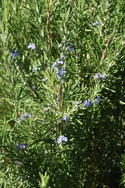Propagation

Take 20 cm cuttings from fresh growth and strip the lower leaves off the cutting and place in water with the lower stripped portion submerged.
Once you have the required amount of cuttings, ready the plant medium.
This is normally a mixture of sand and a potting mixture in a 500 ml plant bag.
Dip the wet rosemary tips into a plant hormone mix and plant into the plant medium.
Planting Method
Planting by large commercial growers is more commonly done by planting seedlings that have been produced in a greenhouse. The seeds are planted into seedling trays about 8 to ten millimetres deep. Once the seeds have germinated and strong seedlings have grown these are planted out into the field. Rosemary seeds have a low germination rate, therefore, sow about four times the seed required. Seeds are inexpensive enough. Once the different varieties are established it is a good practice to start making plants from cuttings for planting in when plants are lost.Spacing
Rosemary plants should be spaced 30 cm apart in rows that are 50 cm apart. This is a stand of around 60 000 plants per hectare. Implement and tractor paths are left for management practices and harvesting.Sowing Time
Sow rosemary seeds into seed trays in a protected environment or greenhouse during June and by early spring the seedlings should be strong enough to plant out into the fieldsPlanting Time
Plant the rosemary seedlings in early spring. In South Africa that is late August early September.Growth Period
Eight to ten weeks in the greenhouse should produce strong rosemary seedlings that are ready to plant out. For fresh rosemary production, some producers start harvesting the fresh growth tips from as early as twelve weeks from planting out. Care should be taken not to over harvest in the first year as this will retard the development of the plant. Fuller harvesting is normally commenced 12 to 15 months after planting. Rosemary plants can be harvested for up to 15 years if managed properly.Fertilization
Before planting, a representative soil sample should be taken and sent for analysis. This will identify soil type and nutrient requirements for the intended crop.As a rough guide, the following recommendation can be used in the absence of soil analysis. An initial 600 kg application of 3:1:5 can be broadcast and incorporated into the top 20 cm of soil prior to planting the rosemary seedlings. This will give the new seedlings a good start in establishing themselves. During the first 12 months, it is important to keep the rosemary plants growing so a further two applications of 400 kg of 3:1:5 can be applied along the plant rows, one in December and another in April. It is advisable to fertilize after every harvest. Do not over fertilize as this reduces the potency of the aroma.
Irrigation
Although the rosemary plant is considered a hardy plant it is not good to stress the plant by over-irrigating, which could cause root diseases or under irrigating and effecting plant growth and production.It is, therefore, best to install moisture measuring devices to continuously monitor the soil.
Depending on soil types and the weather, irrigation volumes will differ from field to field. A good average is between 25 and 35 mm per week during the warm summer months and reducing during cooler or rainy months of the year. Try to not water for the week before harvest. But irrigate immediately after harvest to bring soil back to optimum moisture content.